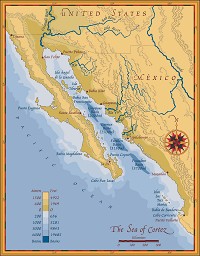Gulf of California
When William Carr and Arthur Pack founded the Arizona-Sonora Desert Museum in 1952, they recognized the Gulf of California (Sea of Cortez) as an integral part of the Sonoran Desert. In fact, the Gulf of California divides the land portion of the Sonoran Desert into two halves, the Baja California Peninsula on the west, and the states of Arizona and Sonora to the east. The surface area of the Gulf is roughly the same size as the land surface area, each about 100,000 square miles-thus, the Sonoran Desert is actually half marine. In fact, it is the only North American desert that is maritime in nature. And, were it not for the Gulf of California and its high evaporation rate, we would not have the moisture-laden air that produces the summer monsoons that characterize the Sonoran Desert, driving its extraordinary productivity and biodiversity, and setting it apart from the other deserts of the New World.
Gulf Estuary - Coastal Wetlands Ecosystem of the Gulf of California: Survey and Conservation Strategies
The coast of the Gulf of California is characterized by ~300 estuaries and other wetlands. These wetlands comprise a unique ecosystem that is home to a rich community of plant and animal life. They are key components of the Gulf's marine food web, generating primary production and releasing nutrients to the sea, and serving as breeding and nursery grounds for numerous fish, invertebrate, and bird species, and even some marine mammals and reptiles. Coastal wetlands are also links to adjacent terrestrial ecosystems; for example, they are feeding stations and nesting sites for numerous resident and migratory bird species. They are especially important in desert ecosystems, forming aquatic oases of high productivity in otherwise dry, low productivity environments. The wetlands of the Gulf of California have received very little research attention and have not yet been given priority conservation status. They are poised for rapid development as marinas, residential and resort developments, and aquaculture sites. In the past 5 years, the estuaries of the southern Gulf have been heavy impacted by explosive conversion into shrimp farms, while those of the northern Gulf are just now beginning to undergo shrimp farm development.
This project is integrating scientific studies and remote sensing with social and economic analyses. It is developing a complete database of all coastal wetlands in the Gulf, including the status of each (knowledge base, extent of anthropogenic impact, conservation potential, etc.). Using a combination of low-elevation flight photography and satellite imagery, the project is generating maps of all coastal wetlands. The project is identifying specific conservation goals for preserving the coastal wetland ecosystem of the Gulf. This initiative is funded by a grant from the David and Lucile Packard Foundation.
The Macrofauna Golfo Project - Compiling and Analyzing a Complete Database of all Animals Known from the Gulf of California
Search the Gulf of California Invertebrate Database
The Gulf of California (Sea of Cortés) is listed among the world's top five seas with regard to productivity and biological diversity. The richness of the marine fauna of the Gulf has long attracted the attention of scientists from around the world. However, threats to the health and integrity of this sea are multiplying rapidly. The scientifically reliable data held in the Macrofauna Golfo Database is a strategic element in developing regional biodiversity conservtion plans for Gulf of California. The Macrofauna Golfo Project has been a 10 year effort, with participation by dozens of professionals in Mexico and the U.S., to catalog every known macrofaunal species (animals larger than 5 mm; ostracods and copepods excluded) that occurs in the Gulf of California.
This project has been funded by grants from Conservation International, CONABIO (the Mexican National Biodiversity Institute), Homeland Foundation, CIAD (Centro de Investigacion en Alimentacion y Desarrollo), and the Arizona-Sonora Desert Museum. Lead investigators are: Richard C. Brusca, Lloyd T. Findley, and Michel E. Hendrickx. The database presents a complete taxonomic catalog of all animal life known from the Sea of Cortés, including information on taxonomy, distribution, depth, and habitat. The complete database will be released in CD version and is available for use online here, and an abridged (printed) version was published by the ASDM Press in 2005 as a "distributional check list."
The Desert Museum's Sustainable Seafood Program
The mission of the Desert Museum's Sustainable Seafood Program is to help consumers understand and recognize unsustainable and environmentally destructive seafood harvesting, and to encourage people to purchase sustainable seafoods in restaurants and markets, with a special focus on seafoods from the Gulf of California (Sea of Cortez). The Desert Museum has partnered with the Monterey Bay Aquarium to research and produce a Gulf of California Seafood Watch Guide. Use this guide and help make a difference! Your wise choices will help create a healthier Gulf of California, and healthier oceans worldwide. Pocket-size Seafood Watch Guides are available at the Desert Museum's ticket window, and can be downloaded here. For more information about the Monterey Bay Aquarium's Seafood Watch Program, or to view the research summaries upon which the Gulf of California Seafood Watch Guide is based, visit this web site.












